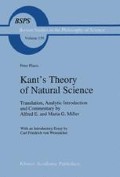Abstract
Our original aim in writing this Translators’ Introduction was simply to summarize the overall argument of Plaass’s treatise as an overview in order to put its individual analyses and arguments into perspective and make them more easily understandable as a whole. In translating his treatise, however, it became clear that it would be important to make certain background assumptions more explicit regarding Kant’s philosophy, ones that Plaass took for granted, but that anyone needs to be explicitly aware of in order to understand crucial parts of the argument. To clarify the perspective and presuppositions from which Plaass was interpreting Kant’s work, it was necessary to reach a new level of understanding of the fundamental issues raised both by Kant and by Plaass and therefore to re-study the pertinent texts more carefully. Plaass’s questions and interpretation served as our guide to Kant’s philosophy of natural science. Nevertheless, in developing our own interpretation of Kant for the sake of understanding Plaass better, we unwittingly discovered that our new reading of the texts led us to a different interpretation in regard to the specifics of the analysis of two interrelated methodological points that Plaass brings to light: (1) the relationship of mathematics to the philosophical method of the MF that Kant calls “metaphysical construction” and (2) how the proof of the “objective reality” (the validity as knowledge) of the necessary determinations of matter is accomplished by mathematics in Kant’s special metaphysics of nature—in contrast to the CPuR, where the “objective reality” of the categories is proved by the Transcendental Deduction. This divergence of interpretations presented us with the problem of how to render both interpretations in an even-handed and accurate manner and to bring out how both interpretations are exemplifications of Plaass’s new approach to the MF, i.e., considering it as built on the reapplication of the Copernican turn in that work in order to develop the necessary metaphysical determinations of matter by construction.
Access this chapter
Tax calculation will be finalised at checkout
Purchases are for personal use only
Preview
Unable to display preview. Download preview PDF.
Rights and permissions
Copyright information
© 1994 Springer Science+Business Media Dordrecht
About this chapter
Cite this chapter
Miller, A.E., Miller, M.G. (1994). Translators’ Introduction and Commentary. In: Kant’s Theory of Natural Science. Boston Studies in the Philosophy of Science, vol 159. Springer, Dordrecht. https://doi.org/10.1007/978-94-011-1126-3_1
Download citation
DOI: https://doi.org/10.1007/978-94-011-1126-3_1
Publisher Name: Springer, Dordrecht
Print ISBN: 978-94-010-4492-9
Online ISBN: 978-94-011-1126-3
eBook Packages: Springer Book Archive

